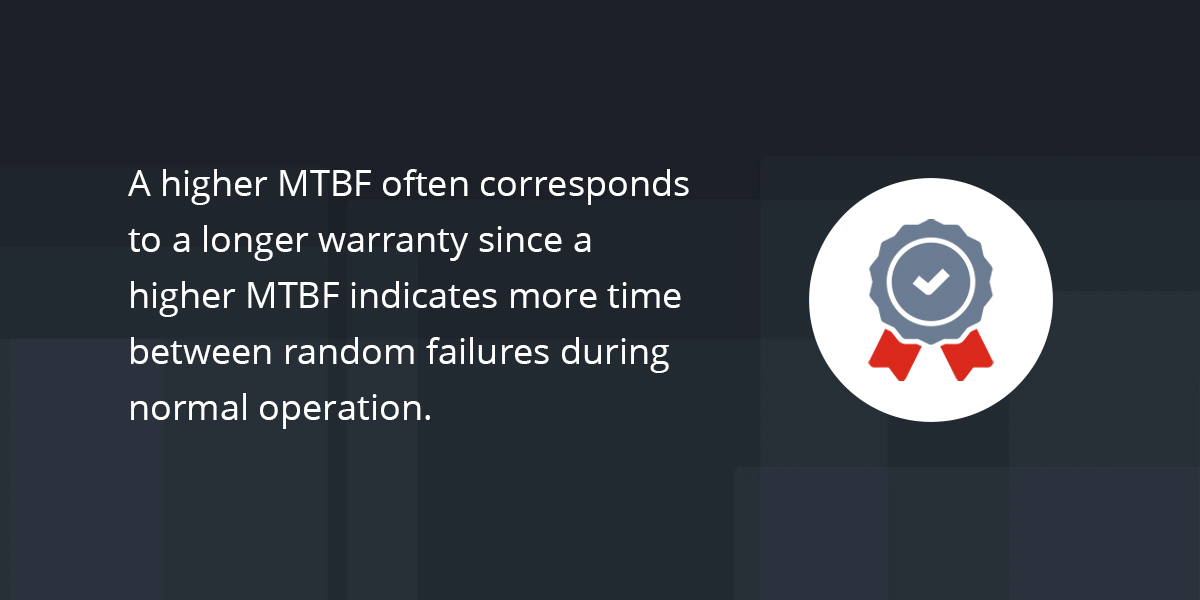RESOURCES
MTBF, Service Life, Warranty, and Product Life Cycle Management
In electrical systems, power supplies stand as the unsung heroes, silently ensuring the continuous and dependable operation of vital equipment across diverse industries. Whether in manufacturing, telecommunications, health care, or other sectors, power supplies are the heartbeat that keeps operations running smoothly.
But what guarantees the longevity and dependability of these vital components? This is where metrics such as mean time between failure (MTBF), service life, warranty, and product life cycle management come into play.
This blog delves into the core of power supply reliability and product longevity, dissecting the intricacies of MTBF and how it relates to a product's service life, warranty, and life cycle. We also discuss why you should consider the failure rate of an asset when choosing a power supply.

What Is the Mean Time Between Failure (MTBF)?
MTBF is a numerical representation of a power supply's expected reliability. It measures the average time that can be anticipated between successive failures during normal operation. The formula is:
- MTBF = 1 / (sum of all part failures)
But what does this mean in practical terms, and why does it matter?
To grasp MTBF's value, you should first understand the concept of the "bathtub curve," a visual representation that encapsulates a product's failure rates over time. This curve consists of three distinct phases — infancy, maturity, and wear-out:
- Infancy: In the early stages, systems may experience what are termed "infant failures." These are the initial glitches that occur as a new product is put to use. A robust design process, meticulous component evaluation, and comprehensive manufacturing testing can mitigate these early hiccups.
- Maturity: The next phase represents the product's useful life, where random failures occur at a predictable rate. The MTBF quantifies the expected time between such random failures. The more components in a system, the lower the MTBF will be. However, note that MTBF applies only to the portion of a component's life where the failure rate remains stable.
- Wear-out: In the final stage, as components age, wear and tear take their toll — leading to increased failures.
So, why is MTBF crucial? It offers a quantitative measure of a power supply's reliability during the maturity phase, helping you make informed decisions when selecting power supplies.
Imagine you're comparing two power supplies for a critical application. One has an MTBF of 100,000 hours, while the other boasts 200,000. The latter signifies a higher probability that the product will last twice as long without succumbing to random failures.
Understanding MTBF enables systematic decision-making in power supply selection, providing a reliable foundation for ensuring uninterrupted electrical performance.
The Role of MTBF in Power Supply Reliability and Life Cycle Management
To understand MTBF's significance in power supplies, you need to know how it affects product reliability and life cycle management.
The following sections cover how MTBF relates to a power supply's service life. We discuss its critical role in shaping warranty assurance to provide a safety net for your investment and how to effectively incorporate MTBF into product life cycle management, optimizing your power supply from design to retirement.
Linking MTBF to Service Life
Service life refers to the duration a power supply is expected to perform without experiencing serious failures. It's the window in which the power supply reliably delivers electrical power without compromising efficiency or safety. For industries such as medical, military, and even residential applications, service life is the bedrock upon which operational continuity is built.
A power supply's service life is typically several years, meaning you can expect it to fail at least once. The MTBF quantifies reliability by dividing the total service life by the number of failures. A higher MTBF represents a longer period of dependable operation before the likelihood of a random failure increases. This translates to a prolonged service life for the power supply, reducing the frequency of replacements or maintenance and minimizing downtime.
Understanding the relationship between MTBF and service life is the cornerstone of power supply reliability. It empowers methodical decision-making, ensuring your power supply aligns seamlessly with your long-term operational needs.

MTBF's Influence on Warranty Assurance
A power supply's warranty period indicates the manufacturer's trust in its reliability and durability. A longer warranty period signifies that the manufacturer will stand behind their product for more time — reinforcing its reliability.
MTBF values and warranty periods are intricately connected. A higher MTBF often corresponds to a longer warranty since a higher MTBF indicates more time between random failures during normal operation. This aligns with the manufacturer's confidence in the power supply's durability.
The correlation between MTBF and warranty is reassuring for buyers seeking reliability. A power supply with a higher MTBF provides extended performance, while a comprehensive warranty package offers peace of mind and protection for your investment.
Understanding this correlation allows you to make informed choices, ensures that your power supply meets your performance requirements, and comes with a warranty that reflects its reliability.
Incorporating MTBF Into Product Life Cycle Management
Product life cycle management (PLM) encompasses the journey of a product from inception to retirement, with each stage demanding meticulous attention to detail. PLM comprises several phases — product conception, design, manufacturing, and maintenance. Each stage presents unique challenges and opportunities to enhance product reliability. Here's where the MTBF comes in:
- Optimizing design: MTBF finds its roots in the design phase. By incorporating MTBF data into the design process, engineers can make informed decisions about component selection and design parameters. This optimization ensures the power supply is inherently reliable from the outset, setting the stage for a longer service life.
- Manufacturing excellence: Manufacturing is where the design's theoretical reliability transforms into a physical product. Here, adherence to the principles established in the design phase, guided by MTBF, ensures that every unit produced meets the reliability standards set during inception.
- Maintenance strategies: As the product enters its operational phase, MTBF plays a pivotal role. It helps in crafting maintenance strategies that align with the anticipated reliability profile. Scheduling maintenance activities based on the power supply's expected MTBF can minimize downtimes and ensure uninterrupted operation.
Incorporating MTBF into PLM is the cornerstone of systematic power supply selection. It influences the product's design and manufacturing while shaping maintenance strategies throughout its service life.
Selecting a Power Supply — Why MTBF Matters
Regarding power supplies, reliability is the keystone for the medical, industrial, and military sectors. But what makes a power supply truly reliable? The answer lies in the intricate interplay of design, components, and manufacturing processes.
- Design excellence: A well-thought-out design is the foundation of power supply reliability. Factors like component selection, thermal management, and redundancy are meticulously considered to ensure the power supply can operate seamlessly within specified parameters.
- Quality components: The choice of components is pivotal. Components with a higher margin or higher ratings, operating within their comfortable limits, contribute to a power supply's longevity. For instance, capacitors with ample voltage ratings last longer.
- Precision manufacturing: Manufacturing processes must mirror the design's intent. Precision assembly, rigorous quality control, and adherence to design specifications are essential.
Reliability is vital for industries like medicine, where a power supply failure can affect patient well-being. Power supply reliability directly impacts productivity and the bottom line in industrial settings. And in military applications, where mission success relies on robust equipment, the stakes couldn't be higher. MTBF indicates reliability by quantifying the expected time between failures during normal operation.
Collaborate With Astrodyne TDI for Tailored Power Solutions
In the intricate landscape of power supply selection, we've navigated the critical factors of mean time between failures, service life, warranty, and product life cycle management. You now understand the interconnectedness of these metrics and their pivotal role in ensuring your electrical systems perform without a hitch. When it comes to power supplies and EMI/EMC filters, you need a partner who understands the intricacies of power supply reliability and the critical role of MTBF.
At Astrodyne TDI, we recognize that power supply reliability isn't just a checkbox — it's your lifeline. With over 60 years of experience as a power supply and EMI filter manufacturer, we're committed to providing unmatched engineering support to meet your unique needs. We're more than a supplier — we're an extension of your engineering team.
Request a quote online or contact us to learn more about our tailored power solutions. Experience the difference that precision engineering and unwavering commitment to reliability can make in your industry.


